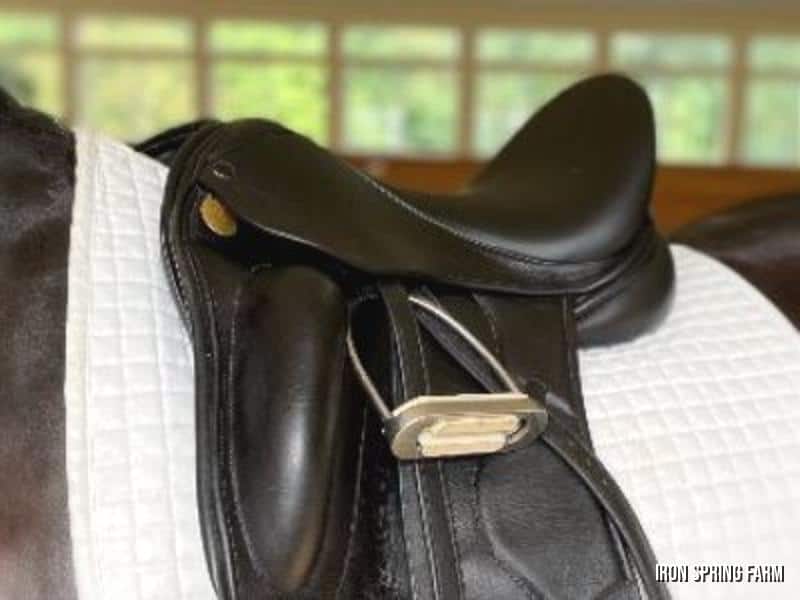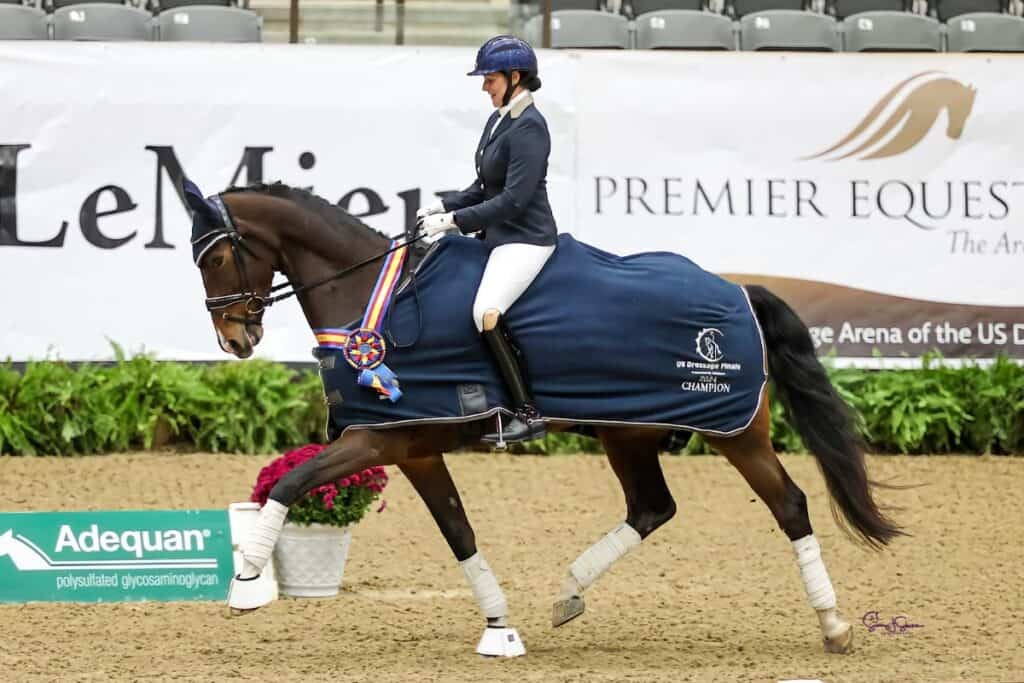There are many factors critical to a horse’s sport performance, including the often-overlooked saddle fit. A well-fitting saddle helps prevent multiple issues, including unnecessary vet bills, a resentful horse and changes in quality of movement. Michelle Novak, training horse manager at Iron Spring Farm, gives an overview of the importance and techniques of proper saddle fit.
A Cautionary Tale
In my professional career, there’ve been many situations in which saddle fit contributed to a host of problems. One of the most extreme examples was a dressage and eventing horse who’d struggled with lameness and back issues. The treating veterinarian tried shockwave therapy, miso-therapy and chiropractic care, along with countless lameness exams—all to no avail. Even after treatment, the horse continued to have attitude problems and lameness under saddle.
At that point, I was brought in for an additional lameness consult. One look at the horse revealed horrible asymmetry in the muscling throughout his body. Among the issues: lack of muscle on the right shoulder compared with the left, right lumbar muscles larger and tighter than the left, poor topline, a large dip behind the shoulders and very tight hamstrings.
Once I saw the saddle fit, I had a hunch this was the cause of the horse’s problems.
We called in a professional saddle fitter to correct the problem. She observed the horse standing in the crossties and ridden, as well as the horse’s sweat patterns after riding. The issues were numerous.
The saddle was high and tight in the front and low in the back. The gullet spacing was so narrow the saddle sat on the horse’s spine. The panels weren’t making even contact with the horse’s back, resulting in bridging. To top it off, the back of the saddle twisted right when the horse was ridden.
A properly fitting saddle was selected. For the first 15 minutes with the new saddle, the horse remained defensive. Once he realized the saddle wasn’t going to hurt him, he took a big breath and started to relax. His back began to move and bend and his facial demeanor softened. He became more round and stopped fighting the rider’s hand and leg. He was also willing to stretch his head and neck down.
When I went back to visit a month later, the client noted a complete turn-around. Once the horse started to use himself better under saddle, the muscular asymmetry improved and he was a happier horse. As for the vet calls, the miso-therapy and shockwave were no longer needed. Continued myofascial and chiropractic treatments supported his proper development.
Common Saddle Fit Issues
While the above story seems extreme, sadly, it’s not uncommon. An ill-fitting saddle can cause lameness and injury, including:
· Decline in quality of movement. If the saddle is too tight in front, the horse becomes reluctant to reach with his front limbs. This can degrade even further into gait irregularity.
· Unwillingness to be soft and supple in topline.
· Reactivity, such as spookiness under saddle.
· Muscle asymmetry from compensation.
· Tightness/soreness through the withers, back, lumbar spine, hamstrings, etc.
Saddle Fit and Young Horses
Since we have many young horses at ISF, we have a variety of saddles to ensure every horse always has the perfect fit. Our selection includes different brands, styles and sizes.
To fit a saddle, I first look at the shape of the horse’s back to determine the tree width. During the saddle fitting process, I try on several different saddles. I make sure the saddle is level on the back, with no bridging of the panels. I make sure the saddle has the correct gullet width to prevent the saddle from resting on the spine. Once the girth is added, I run my hand between the front panels of saddle and horse’s shoulder to make sure it’s not too tight. It’s also important that there is ample room in the shoulders so the saddle doesn’t compromise a full range of motion.
Beware: sometimes a saddle that seems perfect in the barn is no longer a fit once the horse is ridden. The back changes with motion, especially on a more schooled horse. Once a horse learns to lift his back and use himself properly, the saddle may appear unlevel in the cross ties, but fit well while in motion.
Young horses change quickly, so we’re constantly reevaluating saddle fit. As the horse develops and changes, so should the saddle.
Regular Attention to Saddle Fit
It’s good to keep an eye on saddle fit as part of your daily routine. Keep these points in mind:
- Seat balance. Is it high in front or behind?
- Shoulder tightness. Can you pass your hand between the saddle and your horse’s shoulder blade on both sides? It should be neither too tight nor too loose.
- Spine. Is the saddle resting on your horse’s spine?
- Even, steady contact. Does the saddle lose contact with your horse’s back when he’s ridden?
- Straightness. Does the saddle fall left or right?
- Bridging. Do the panels lie flat against the horse?
Find a Professional Saddle Fitter
A professional saddle fitter should be a permanent member of your horse’s team. The best way to find a reputable fitter is to ask someone knowledgeable to steer you in the proper direction and then do your research.
A good saddle fitter will watch your horse work in the current saddle, adjust as needed and watch the horse again. DO NOT RUSH the process. It’s better for the fitter to reflock little by little than rush through it.
If you do need a new saddle, try different brands, styles and types. Watch and feel how your horse moves and reacts to the change. Your horse will let you know if the saddle is a good fit or not.
When it comes to keeping your horse a happy athlete, saddle fitting is on par with proper veterinary care, quality shoeing and good footing. Develop a solid system for ensuring proper saddle fit and enjoy the benefits every time you put a foot in the irons.
Disclaimer:
All content provided by Iron Spring Farm is general and for informational purposes only. Content may also not constitute the most up to date information. Nothing in this content is intended to constitute veterinarian advice or to serve as a substitute for consultation with a veterinarian. Always seek the advice of your veterinarian or other qualified provider with any questions that you may have about the treatment and care of your horse.
Any reliance that you place on the information provided is strictly at your own risk and Iron Spring Farm, its officers, employees, representatives, and agents, hereby disclaim any and all liability to any party for any direct, indirect, implied, punitive, special, incidental, consequential or other damages arising directly or indirectly from access to or use of any content provided to the maximum extent permitted by law.










